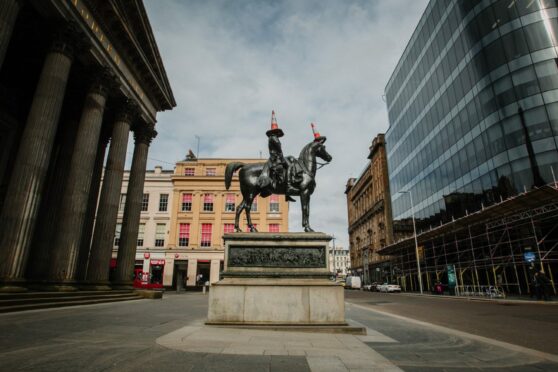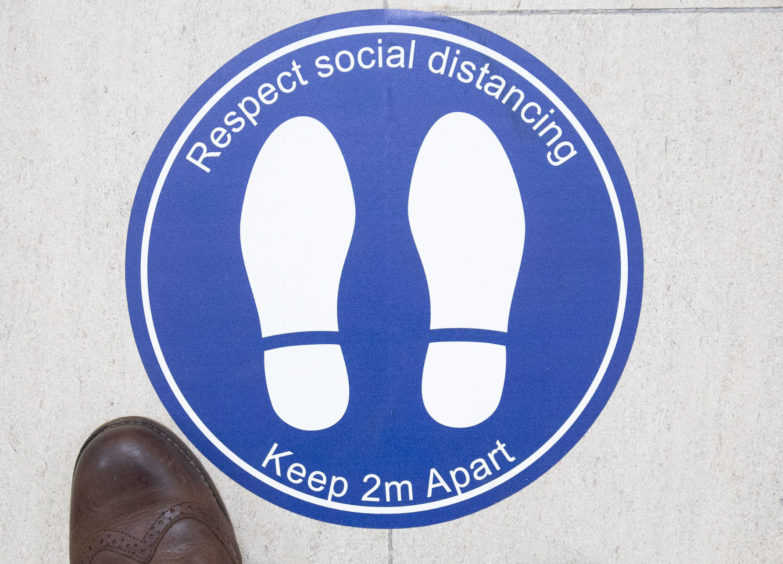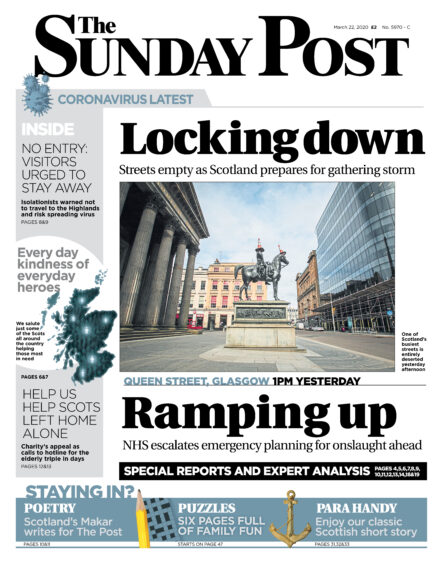
Soon the guidelines, restrictions and lockdowns that have ruled our lives since the start of the pandemic will end in Scotland, almost exactly two years since they began.
They will be eased from March 21 as Scotland follows the UK’s other three nations out of lockdown, but it will be the last. Have we really learned to live with Covid? Are we prepared for another variant? Or even another virus, another pandemic?
Professor Mark Woolhouse, an eminent infectious diseases experts and government adviser, believes we should never enter another lockdown as quickly as we did in 2020.
He backs Scotland’s more cautious approach to lifting restrictions but says we rushed into lockdown too quickly after failing to act sooner after the first alarming reports of a new virus in Wuhan, China.
He said: “Lockdown isn’t a public health policy. It is a failure of public health policy. It’s what you do when you haven’t managed to implement effectively all the more sensible options.
“People are often reluctant to accept the need for early interventions, but I think when we realised that’s the way to keep out of lockdown they became much more attractive.
“I would argue that Omicron was actually a very good example. The severity of the illness was much less, not least because of the vaccination programme, but nevertheless the number of cases could have risen very high, and one of the reasons they didn’t is that across the UK we did act very quickly.
“While the Scottish Government did add some social distancing type measures, two things made the difference with Omicron – self-testing and people changing their behaviour. With self-testing we got it wrapped up really quickly, and people changed their behaviour because we were all very well aware that wave was coming .
“And I think those things would make a difference next time when the next variant comes along as well.”
He fears Covid may never be eradicated but that future lockdowns should be avoided. On Thursday, rules on self-isolation, testing and face coverings in public places were lifted in England as part of Boris Johnson’s “living with Covid” plan. Funding for free testing will end on April 1.
In Scotland, restrictions will not be lifted until March 21 and testing will continue to remain free for now. Woolhouse, professor of infectious disease epidemiology at Edinburgh University, said the number of cases in Scotland justified the approach taken by Nicola Sturgeon.
Woolhouse, author of new book The Year The World Went Mad: A Scientific Memoir, said: “I welcome the ending of restrictions and I don’t have any problem with the timing of it. I think the data is very supportive of ending restrictions now.
“The data is actually slightly different in England and Scotland. In England, there has been a steady and quite rapid decline in the number of people in hospital and an even more rapid decline in cases over the past few weeks.
“In Scotland, our case count is quite steady and over the last week the number of people in hospital with Covid-19 has increased slightly. I’m an epidemiologist and I’m very much in favour of following data not dates. I don’t think we’ve done that very well so far, but on this occasion I think the Scottish data warrants being slightly more cautious this time.”
Free Covid testing is to end in England on April 1, with pharmacy Boots already charging £5.99 for the delivery of a single lateral flow test, £17 for four. The first minister has criticised the UK Government for ending funding but it is unclear if the Scottish Government will now start paying for free tests and, if so, for how long.
Woolhouse fears far fewer people, particular those on low incomes, will take tests if they have to pay for them.
He said: “It’s going to discourage an awful lot of people from doing it. You’ve got to anticipate a very significant fall-off in the number of people accessing it. I personally would continue to use them, though probably less frequently. If, for example, I was going to see an elderly relative, I would pay my £5.99 without a second thought.
“But it’s very obvious that it is only going to exacerbate the differences between the more deprived and the least deprived.”
He added: “Clearly they have to be paid for somewhere, but I am in favour of making them as freely accessible as they possibly can be. So I’m more in favour of Scotland’s approach to that than England’s right now.”
Woolhouse said he had argued at a meeting of the Scottish Government’s Covid-19 advisory group in March 2020 that people would have to be tested on an unprecedented scale, perhaps even weekly testing.
He said: “While it wouldn’t be fair to say I was laughed out the room, I was, gently, politely, told off. I was told that my advice had to be realistic and this wasn’t realistic.
“Testing had been in my mind from the beginning, and there is very good evidence that self-testing was very important in bringing the Omicron wave under control.
“The uptake of it in Scotland was fantastic – 85% people using self-tests once a week and 50% three times or more a week. I’m very confident that people prepared to use the tests were also prepared to change their behaviour if they tested positive.”
In his book, Woolhouse, who has studied the emergence of new viruses for more than 20 years, said he began warning the Scottish Government about Covid in January 2020.
He first emailed Catherine Calderwood, Scotland’s then chief medical officer, on the day the World Health Organisation reported there had been more than 200 cases and six deaths from the new virus in China, and that Scotland needed to start preparing for an epidemic.
Woolhouse said he received a reply to his emails telling him everything was under control. He was appointed to the Scottish Government’s expert committee, the Scottish Covid-19 Advisory Group, but it did not meet until March 26, three days after the UK went into lockdown. He said the lack of action may have been due to “sheer disbelief” by officials and politicians.
Woolhouse was concerned about the damage lockdown would cause but by that stage there “was no other option on the table”.
He said when the UK went into its first lockdown fewer than 400 people had died and when it came out that number had risen to more than 40,000. He said many of the people who died had been infected before the lockdown, and that lockdown came too late to prevent those infections.
He said UK should have acted earlier, but that action taken did not have to be a full lockdown.
Woolhouse argued many restrictions, such as the closure of schools, were not needed. He told The Sunday Post: “I don’t think the closure of schools was warranted, and as evidence for that Sweden didn’t close them for children under 15. Staying indoors that was completely unnecessary. This virus does not transmit well outdoors, unless there is intimate contact, but for the general public going about their business outdoors there’s very little threat.
“We didn’t need to be told to stay indoors, and it caused immense distress. One community I feel very strongly about, because of my job, is the university students. I think they had the most dreadful time, most of them stuck in student accommodation, not allowed out very much, for no good reason.
“There was no need to keep us indoors. I think that was a real shame that caused an awful lot of unnecessary damage and harm.”
He described lockdown as a “monumental mistake on a truly global scale”. He said: “I think history will look very harshly on this. People will be staggered by what we did, particularly the harm we inflicted on young people and children. The vast majority of them were never at significant risk from this virus, and yet they were made to shoulder so much of the harms done by lockdown. I think that’s morally wrong.”
Despite the removal of restrictions, Woolhouse also warned that Covid-19 is unlikely to be eradicated in the foreseeable future. He said: “Clearly that’s going to put extra strain on resources and on budgets, and I don’t see any way round that.
“Nonetheless, as time goes on, I hope the general trend will be its burden slowly decreases but, as we’ve seen, most likely in a sporadic way because it’s one variant after another. We might get waves, but hopefully the waves become less and less harmful over time.
“But I don’t know that for certain, and so we’re going to have to be vigilant and have to maintain the capacity to respond with greater measures if they are warranted.”
The Year The World Went Mad: A Scientific Memoir, by Mark Woolhouse, is published by Sandstone Press

Enjoy the convenience of having The Sunday Post delivered as a digital ePaper straight to your smartphone, tablet or computer.
Subscribe for only £5.49 a month and enjoy all the benefits of the printed paper as a digital replica.
Subscribe © Jane Barlow/PA Wire
© Jane Barlow/PA Wire © SYSTEM
© SYSTEM